I get a break in the gun season for thanksgivin weekend so I'll practice up with my lyman .54 trade rifle. Last time I shot it in October I shot good deer hunting groups off hand at 50 yards. But it didn't fire every time. Twice the flint struck the frizzen but didn't set off the prime because of the lack of sparks. The flint I was using back then had been "recycled" by me so that I could still shoot. The flint was very short and dull. It was a very fat flint which I found are hard to keep sharp. Now I have good Tom Fuller english flints that spark well bevel down. I always have my guns clean and flushed out but use Barricade gun oil after cleaning so I wipe with a rubbing alcohol patch and then dry ones to take out most of it. I use 4ffffg priming powder so I know keeping it dry is important. Is there anything I'm missing? If there's wet weather I probably will use the percussion muzzleloader instead of flintlock because I don't want to mess up with the small amount of experience I have with flintlocks. Thanks.
-
This community needs YOUR help today. We rely 100% on Supporting Memberships to fund our efforts. With the ever increasing fees of everything, we need help. We need more Supporting Members, today. Please invest back into this community. I will ship a few decals too in addition to all the account perks you get.

Sign up here: https://www.muzzleloadingforum.com/account/upgrades -
Friends, our 2nd Amendment rights are always under attack and the NRA has been a constant for decades in helping fight that fight.
We have partnered with the NRA to offer you a discount on membership and Muzzleloading Forum gets a small percentage too of each membership, so you are supporting both the NRA and us.
Use this link to sign up please; https://membership.nra.org/recruiters/join/XR045103
You are using an out of date browser. It may not display this or other websites correctly.
You should upgrade or use an alternative browser.
You should upgrade or use an alternative browser.
Flintlock Hunting Situation Gun Care Tips?
- Thread starter luieb45
- Start date

Help Support Muzzleloading Forum:
This site may earn a commission from merchant affiliate
links, including eBay, Amazon, and others.
ohio ramrod
75 Cal.
- Joined
- Aug 21, 2008
- Messages
- 7,473
- Reaction score
- 2,204
weather it is flint or percusion keeping the lock area dry is the number one thing when hunting. I like a small piece of wool laid over the lock area anytime a shot isn't likely. Just lay a piece over the lock area making sure it doesn't get "tangled". You can "shake it off in a fraction of a second. :hmm:
wattlebuster
69 Cal.
- Joined
- Aug 21, 2010
- Messages
- 3,679
- Reaction score
- 350
In damp weather i change my prime about every 30 min or so. works for me. and the only way to gain experience is to do what you already been doin. from the posts i been reading that you put on here you ARE on the right track just keep at it. Good Luck to you :thumbsup:
- Joined
- Jun 12, 2005
- Messages
- 7,971
- Reaction score
- 966
i understand that 4F absorbs moisture from the surrounding air a bit faster than coarser grades, so I've heard that some folks go to 3F when they're in the field, which makes it possible to change out the prime less often (but you should still do so, to make sure you don't have damp powder in the pan when the humongous buck turns the corner and says, "Hi there, shoot here!")
I would recommend that you try this out before you depend on it, though. It has been my experience that 4F doesn't get me any appreciable increase in lockspeed over 3F, but that's just me, and i'm not a very good shot with a flintlock (yet); so check out both methods and see what works best for you.
(Gives you a great excuse to spend more time at the range!)
Good luck with your hunt, and
Make good smoke!
I would recommend that you try this out before you depend on it, though. It has been my experience that 4F doesn't get me any appreciable increase in lockspeed over 3F, but that's just me, and i'm not a very good shot with a flintlock (yet); so check out both methods and see what works best for you.
(Gives you a great excuse to spend more time at the range!)
Good luck with your hunt, and
Make good smoke!
Ft. Jefferson
40 Cal.
- Joined
- May 5, 2010
- Messages
- 375
- Reaction score
- 3
As always, practice makes perfect, just another reason to take your flinter hunting. Early on i deer hunted with percussion and squirrel hunted with fint. Then, as i got confident with a flinter in the woods, i started deer hunting with flint and have never looked back. If ya have trouble with the flinter, at least all you miss is the squirrel.
paulvallandigham
Passed On
- Joined
- Jan 9, 2006
- Messages
- 17,538
- Reaction score
- 80
Use your same powder put in the barrel for priming in damp weather, but check it every 20-30 minutes. You will be able to tell your 4F or 3Fg powder is beginning to be damp by the forming of a crust on the top of the priming charge. I use my pick to test the prime: If priming powder sticks to the dry pick, I change the prime. Simple.
You need to use more than an alcohol soaked patch down that barrel to remove ALL the barricade. Pour some alcohol down and let it flow through the powder chamber, the small hole at the back, and then into and through the flash channel to the TH, so it pours out of the TH into a rag. The alcohol will evaporate any oils in those tiny places, and leave them dry, so that your main charge can flow down into the flash channel, and with the rap with the butt of your hand to the side of the stock opposite the TH, over to the TH for sure ignition.
You seem to now understand the need to use a new flint when hunting, and from what you write, you are getting good sparks. If that is the case, simply check to make sure the cock screw is down tight on the flint and its wrap, the flint is mounted square to the frizzen, and you are ready to go.
I use a "hammer-stall" over my frizzen, whenever I am carrying the gun loaded and primed in the field. Its a little leather " hat", if you will, that fits over the top of the frizzen, but is easily removed. A leather thong ties the hammer stall to my trigger guard so its not lost when removed. The stall prevents the gun from firing is something happens to lift my cock back off its half cock notch, and then release the cock to fall forward. The flint edge strikes the leather, and not the steel frizzen. ERGO, No sparks, and no "Unintended Discharge".
Its the Closest thing to a real "SAFETY" You can make for any flintlock. :thumbsup:
You need to use more than an alcohol soaked patch down that barrel to remove ALL the barricade. Pour some alcohol down and let it flow through the powder chamber, the small hole at the back, and then into and through the flash channel to the TH, so it pours out of the TH into a rag. The alcohol will evaporate any oils in those tiny places, and leave them dry, so that your main charge can flow down into the flash channel, and with the rap with the butt of your hand to the side of the stock opposite the TH, over to the TH for sure ignition.
You seem to now understand the need to use a new flint when hunting, and from what you write, you are getting good sparks. If that is the case, simply check to make sure the cock screw is down tight on the flint and its wrap, the flint is mounted square to the frizzen, and you are ready to go.
I use a "hammer-stall" over my frizzen, whenever I am carrying the gun loaded and primed in the field. Its a little leather " hat", if you will, that fits over the top of the frizzen, but is easily removed. A leather thong ties the hammer stall to my trigger guard so its not lost when removed. The stall prevents the gun from firing is something happens to lift my cock back off its half cock notch, and then release the cock to fall forward. The flint edge strikes the leather, and not the steel frizzen. ERGO, No sparks, and no "Unintended Discharge".
Its the Closest thing to a real "SAFETY" You can make for any flintlock. :thumbsup:
- Joined
- Jan 3, 2004
- Messages
- 14,767
- Reaction score
- 314
Sounds like you're on the right track to reliability already, but fine tuning never hurts in the wet. Using your percussion if it's wet will simplify things some, but with care your flinter won't be a problem either.
One thing with your percussion- The only failure I've seen in wet weather was due to sweat rather than rain. My hunting pard hung his capper on a thong around his neck, and sweat fouled the caps. He still hangs it from a thong around his neck, but puts it in a shirt pocket rather than inside his shirt.
It's real wet country here, and it's taught me a few lessons about flinters.
With rain a brimmed hat or oversize hood on your coat is good so you can lean over the lock and have a dry spot while you mess with the prime.
Carry a few Kleenex or a rag in your pocket so you can thoroughly dry the pan, frizzen and flint each time you change prime.
Powder residue is more of a problem than the powder itself, because it soaks up water like a sponge, even from the air.
In my experience 4f is a bad deal in terms of moisture in the air. Sure you can dump it and change it frequently, but 3f is better. This year I experimented with 2f since that's what my 62 was charged with, and it was great.
Some kind of cover for the lock is a pretty good idea, whether a cows knee or something else. I tried hanging the flap of my raincoat over the lock, but it was impossible to keep it there while still hunting in our rough country.
Enuff yack. Enjoy your hunt, whichever rifle you choose.
One thing with your percussion- The only failure I've seen in wet weather was due to sweat rather than rain. My hunting pard hung his capper on a thong around his neck, and sweat fouled the caps. He still hangs it from a thong around his neck, but puts it in a shirt pocket rather than inside his shirt.
It's real wet country here, and it's taught me a few lessons about flinters.
With rain a brimmed hat or oversize hood on your coat is good so you can lean over the lock and have a dry spot while you mess with the prime.
Carry a few Kleenex or a rag in your pocket so you can thoroughly dry the pan, frizzen and flint each time you change prime.
Powder residue is more of a problem than the powder itself, because it soaks up water like a sponge, even from the air.
In my experience 4f is a bad deal in terms of moisture in the air. Sure you can dump it and change it frequently, but 3f is better. This year I experimented with 2f since that's what my 62 was charged with, and it was great.
Some kind of cover for the lock is a pretty good idea, whether a cows knee or something else. I tried hanging the flap of my raincoat over the lock, but it was impossible to keep it there while still hunting in our rough country.
Enuff yack. Enjoy your hunt, whichever rifle you choose.
luie b said:I get a break in the gun season for thanksgivin weekend so I'll practice up with my lyman .54 trade rifle. Last time I shot it in October I shot good deer hunting groups off hand at 50 yards. But it didn't fire every time. Twice the flint struck the frizzen but didn't set off the prime because of the lack of sparks. The flint I was using back then had been "recycled" by me so that I could still shoot. The flint was very short and dull. It was a very fat flint which I found are hard to keep sharp. Now I have good Tom Fuller english flints that spark well bevel down. I always have my guns clean and flushed out but use Barricade gun oil after cleaning so I wipe with a rubbing alcohol patch and then dry ones to take out most of it. I use 4ffffg priming powder so I know keeping it dry is important. Is there anything I'm missing? If there's wet weather I probably will use the percussion muzzleloader instead of flintlock because I don't want to mess up with the small amount of experience I have with flintlocks. Thanks.
Gun cover. Flintlock in a cover is as good or better than a percussion without.
Leather cover, smooth side in so it slides easier, coated with Sno-seal will waterproof and stiffen it somewhat to make it easier to get off.
Dan
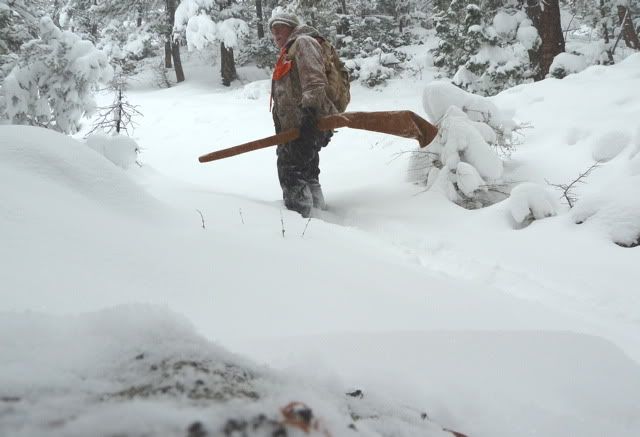
- Joined
- Jun 12, 2005
- Messages
- 7,971
- Reaction score
- 966
Dan, that's a nice photo .. is the cover one long tube, or (from what i can see in the photo) is it open at the bottom to about the triggerguard?
Do i assume correctly that to use this you simply tip the rifle muzzle down and the thing sorta slides off? how do do this without spooking the game?
thanks!
Do i assume correctly that to use this you simply tip the rifle muzzle down and the thing sorta slides off? how do do this without spooking the game?
thanks!
Congress Own Regiment
40 Cal.
- Joined
- Aug 26, 2007
- Messages
- 311
- Reaction score
- 0
you can sharpen a dull flint by knapping the edge.
If you are not skilled at this or have a stone that is not beveled right a diamond stone wheel or cutting bit in a moto-tool can shape them to a prefect edge. be shore to wear safety glasses.
flint lock hunting is very much doable in the rain just keep your lock covered and change the priming charge often. this goes for damp weather as well. be mindful of lubes you use in your weapon as the temp. drops lots of lubes get stiff and will slow or stop moving parts.
If you think dampness go to your gun unload it and clean dry reload. it is better for your peace of mind knowing the charge is good
If you are not skilled at this or have a stone that is not beveled right a diamond stone wheel or cutting bit in a moto-tool can shape them to a prefect edge. be shore to wear safety glasses.
flint lock hunting is very much doable in the rain just keep your lock covered and change the priming charge often. this goes for damp weather as well. be mindful of lubes you use in your weapon as the temp. drops lots of lubes get stiff and will slow or stop moving parts.
If you think dampness go to your gun unload it and clean dry reload. it is better for your peace of mind knowing the charge is good
paulvallandigham
Passed On
- Joined
- Jan 9, 2006
- Messages
- 17,538
- Reaction score
- 80
"How do you take the scabbard off without spooking game?"
Well, you don't move at all if the game is actually looking at you, FOR ONE!
You wait for the animal to move behind a tree, or look another direction. You stoop down to lower your own profile, and move SLOWLY. Don't let the Scabbard "Slide off" the gun. Slowly take it off the gun- that means with slow, short movements, low to the ground, where the movement is concealed by brush, or by the tree you are standing behind.
YOU ARE STANDING NEXT TO A TREE, aren't YOU???? You have planned your own personal movements to follow game trails, and allow yourself to move from one tree to the next, crouching to cross open areas, slowly????
You are not just Busting through the brush, like a two-legged bulldozer, expecting to see deer, standing and waiting to greet you????
In snow, like is shown in this picture, you have the advantage of the snow muffling any footsteps you make, as well as the sounds of breaking twigs, and crushing leaves on the forest floor. The disadvantage is that You DON'T have these same things working for you to HEAR deer coming towards you!! :idunno: Because you can't hear their movement, Deer seem to " Appear" suddenly, without warning.
However, if you are Not moving fast, in the open, you will see the deer, as they stop to scan any open area before they move through it. Expect the young does to come out first, and the large bucks to hang back behind the does. Don't be surprised if a doe stops in an open area( like a trail as shown) to munch grass growing along the trail. That is really a cover so that she can both look and Listen to sounds along that "funnel" that you see as a Path through the forest.
Around here, most deer stay in their beds during heavy snows like this. They only feed after dark, and before dawn. Unless you know where they are bedding( part of pre-hunt scouting), don't expect them to be wandering around at high noon. The only exception to this I know and have seen repeatedly, is when there has been bad weather for a number of days: Then deer move out to exercise and feed sometimes. If they can fill their bellies with a night feed, they will stay in their beds all day long. Know their feeding areas, and their bedding areas.
Expect them to bed down out of the wind,[not the wind you feel 6 feet off the ground numbing your face, but the slower winds blowing across the ground down at your ankles] and inside woods when they are available, so that they can both stay warmer, and hear better.( There are bigger twigs, and branches for predators to step on and break, making enough sounds to be heard, in woods, compared to in open fields, and grassy areas.)
While you may think that the floor of woods is flat, in reality there are all kinds of shallow holes, dips, and cutbanks in woods- even on the flat land here in Illinois, that allow deer to hide behind or in. A downed tree offers great cover for bucks- Warm piles of dry dead leaves to lay in, the trunk of the tree to block the wind-- and they will simply let human hunters walk right by them- often only a few feet away, rather than jump up and expose themselves.
The only other reason deer move from their beds seems to be when other hunters scare them into moving.
One last note about hunting in snow: As the Temperature drops below zero, the snow begins to SQUEAK under your boots, AND the pitch of that squeak rises, making it easier to hear further from you.
I always thought that was the Almighty's way of telling me its too cold out to be hunting!, but I don't live and hunt in Northern Canada, or Alaska. :haha: :surrender: :hmm: :hatsoff:
Well, you don't move at all if the game is actually looking at you, FOR ONE!
You wait for the animal to move behind a tree, or look another direction. You stoop down to lower your own profile, and move SLOWLY. Don't let the Scabbard "Slide off" the gun. Slowly take it off the gun- that means with slow, short movements, low to the ground, where the movement is concealed by brush, or by the tree you are standing behind.
YOU ARE STANDING NEXT TO A TREE, aren't YOU???? You have planned your own personal movements to follow game trails, and allow yourself to move from one tree to the next, crouching to cross open areas, slowly????
You are not just Busting through the brush, like a two-legged bulldozer, expecting to see deer, standing and waiting to greet you????
In snow, like is shown in this picture, you have the advantage of the snow muffling any footsteps you make, as well as the sounds of breaking twigs, and crushing leaves on the forest floor. The disadvantage is that You DON'T have these same things working for you to HEAR deer coming towards you!! :idunno: Because you can't hear their movement, Deer seem to " Appear" suddenly, without warning.
However, if you are Not moving fast, in the open, you will see the deer, as they stop to scan any open area before they move through it. Expect the young does to come out first, and the large bucks to hang back behind the does. Don't be surprised if a doe stops in an open area( like a trail as shown) to munch grass growing along the trail. That is really a cover so that she can both look and Listen to sounds along that "funnel" that you see as a Path through the forest.
Around here, most deer stay in their beds during heavy snows like this. They only feed after dark, and before dawn. Unless you know where they are bedding( part of pre-hunt scouting), don't expect them to be wandering around at high noon. The only exception to this I know and have seen repeatedly, is when there has been bad weather for a number of days: Then deer move out to exercise and feed sometimes. If they can fill their bellies with a night feed, they will stay in their beds all day long. Know their feeding areas, and their bedding areas.
Expect them to bed down out of the wind,[not the wind you feel 6 feet off the ground numbing your face, but the slower winds blowing across the ground down at your ankles] and inside woods when they are available, so that they can both stay warmer, and hear better.( There are bigger twigs, and branches for predators to step on and break, making enough sounds to be heard, in woods, compared to in open fields, and grassy areas.)
While you may think that the floor of woods is flat, in reality there are all kinds of shallow holes, dips, and cutbanks in woods- even on the flat land here in Illinois, that allow deer to hide behind or in. A downed tree offers great cover for bucks- Warm piles of dry dead leaves to lay in, the trunk of the tree to block the wind-- and they will simply let human hunters walk right by them- often only a few feet away, rather than jump up and expose themselves.
The only other reason deer move from their beds seems to be when other hunters scare them into moving.
One last note about hunting in snow: As the Temperature drops below zero, the snow begins to SQUEAK under your boots, AND the pitch of that squeak rises, making it easier to hear further from you.
I always thought that was the Almighty's way of telling me its too cold out to be hunting!, but I don't live and hunt in Northern Canada, or Alaska. :haha: :surrender: :hmm: :hatsoff:
rafterob
62 Cal.
The good thing is when it gets cold enough you can walk on top of the snow because it is frozen solid. But when its that cold you got to be nuts (or from Minnesota) to be outside in the first place.
MSW said:Dan, that's a nice photo .. is the cover one long tube, or (from what i can see in the photo) is it open at the bottom to about the triggerguard?
Do i assume correctly that to use this you simply tip the rifle muzzle down and the thing sorta slides off? how do do this without spooking the game?
thanks!
This is actually my normal cover for this gun used when its being transported. I have another that is open up the seam about 8"+that I use for shorter rifles. But its about 8" too short for this one. I need to make a dedicated hunting case for this rifle well. I used the long case to reduce dings. When hunting in the snow (or even when its dry) on slopes as steep as I sometimes hunt, you WILL slip and/or fall at some point.
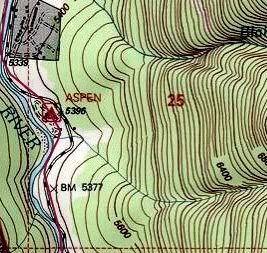
over 2000 ft of rise in about 5/8 of a mile.
So far as getting the cover off. The long cover is a bigger pain to get off than this one is
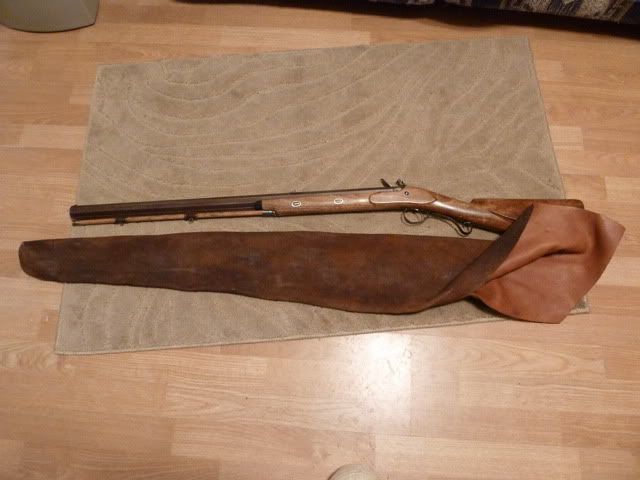
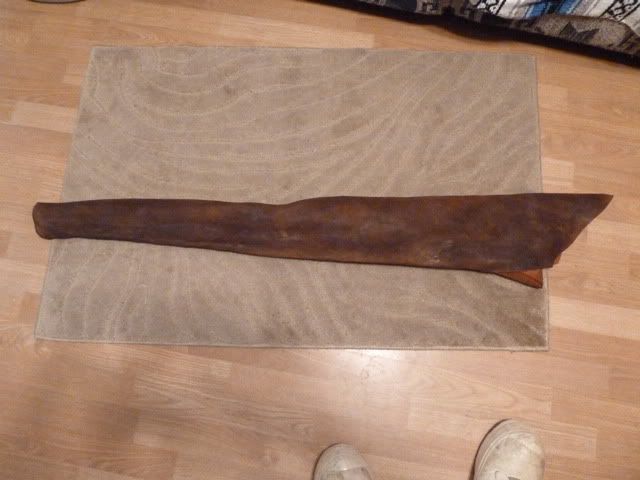
But I wanted to longer cover since it gives better protection.
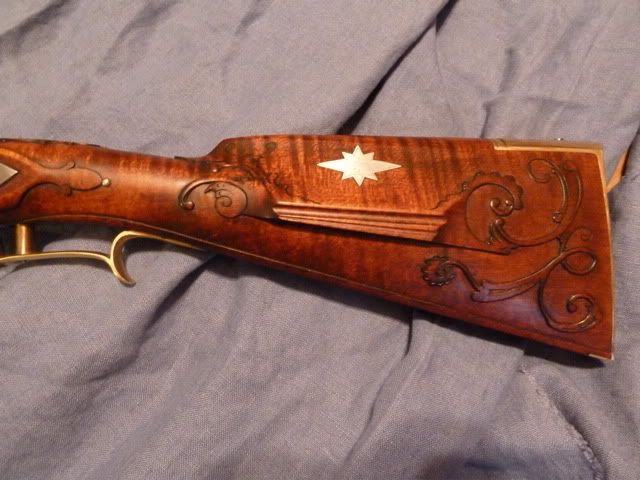
For those worried about spooking game.
Don't matter how easy it is to get the gun into action if it misses fire.
The looser fit greased cover almost falls off. If the hunter thinks he is close to game he can remove the shooting hand glove and keep it under the cover at the wrist of the rifle or remove teh cover all together. It will then stay fairly warm and ready to shoot once the cover is slide off.
Its simply not possible to keep a FL dry when its like in the photo with anything else. It helps if the gun can be kept in the cold for two hours before exposure to the elements but this only works in the cold and if hunting right outside the door. If its at or just under freezing or raining only a near full length cover is really effective. A wet frizzen will usually not spark so greasing around the pan is a waste of time if the frizzen face is not kept dry.
With a cover I don't even need to check the priming unless its suspected the pan got knocked open and this can be checked without much exposure right in the case.
Dan
I put a porcupine quill in the vent when it is really wet and don't prime until right before I think I'm going to shoot, you can do it faster than you think. with a tight greased patch ball and a quill in the vent the powder charge will never foul. We always have ton of snow here in ND during our ml season. We already have a foot now and are expecting anouther the next couple of days. Should be right around zero for the opener, I wussed out and got a pop up blind this year and a heater.
- Joined
- Jan 29, 2010
- Messages
- 1,808
- Reaction score
- 6
texcl said:Should be right around zero for the opener,
You guys are INSANE!
Once it hits the 20s I'm gonna be nowhere to be found.
justafeedboy
36 Cal.
- Joined
- Feb 23, 2006
- Messages
- 54
- Reaction score
- 0
I wait to prime till I see an animal I'm going to shoot. On half cock I wipe the flint prime the pan and then pick the vent hole. When the animal is committed (head behind a tree) the gun gets cocked and aimed. All motion is done when I can't see the head of the animal it can't see me. This method has always worked for me. You might have to give up some situations because they happen too fast. But the more you practice the routine the quicker, quieter, and faster you get at it.
From what everyone is saying it seems like if weather is ok and the gun is clean(pan) that it'll fire. If I can get a good off-hand group at 50 yards when I shoot the flintlock this weekend I will possibly use it 2nd season or muzzleloader season. What I worry about for muzzleloader season is that the weather will be crappy like usual. But instead of buying or making a fancy cow's knee for this year putting a golf towel over the lock might work. Then not priming the gun with a tooth pick in lock would also help.
justafeedboy said:I wait to prime till I see an animal I'm going to shoot. On half cock I wipe the flint prime the pan and then pick the vent hole. When the animal is committed (head behind a tree) the gun gets cocked and aimed. All motion is done when I can't see the head of the animal it can't see me. This method has always worked for me. You might have to give up some situations because they happen too fast. But the more you practice the routine the quicker, quieter, and faster you get at it.
Everyone handles this in the way they think best.
But...
To paraphrase James Forsythe "It is one thing to hunt animals that fly FROM you and quite another to hunt animals of the audacious type that fly AT you". He was speaking of Tigers and such since he hunted in India. Where I live its bears, cats and wolves.
You round a bend in the trail and discover a bear on a dead elk 15 yards away. It is virtually certain you will be attacked. One of the BPCR shooters I used to know was by Mtn Lion about 25 years ago. have not had any wolf attacks yet but they are documented man killers.
I can shoot through a cover worse comes to worse. Getting the bear to let me pull a quill and/or wipe away the water and prime the gun is a stretch.
I found fresh Gbear tracks, proabably a 400+ pounder, on the way out of a place I was hunting with my 50 cal flintlock about 3 weeks ago.
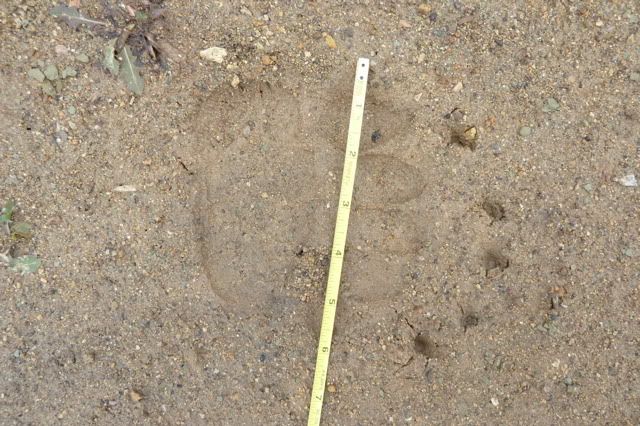
About a week later someone shot a Gbear off his elk in the same drainage.
A good friend hunts in an area in northern WY where the Gbears have started coming to gunshots like dinner bells. At our last conversation he told me one hunter shot three this year. 1 when he shot his elk and 2 more that attacked him and his friend before they even got to the elk the friend had shot. At that time he said there had been almost 40 Gbears killed in WY, most in the areas around YNP and reported and only 5 or so were road kills.
If the gun gets wet it don't work.
Why would I try to prime a wet/damp pan if I can keep it dry in the first place?
Ever try to get a spark from a frizzen/flint with a layer of water on it? VERY iffy in my experience in dipping a lock in a sink full of water.
A waterproof/resistant cover solves the problem.
Its also HC back into the 18th century.
Dan
justafeedboy
36 Cal.
- Joined
- Feb 23, 2006
- Messages
- 54
- Reaction score
- 0
I've shot a coastal brown bear, I know what you are saying. It's a totally different situation. I would want my gun primed. But where I live I rule the woods. In my hunting I've come in contact with 25+ black bear encounters and 26 brown bear encounters. I've held my ground at my closest brown bear encounter at 1 yd, gun drawn, safety off, he was half a step from being shot in the head. For the most part they just want to get away. Suprising one,encountering one with food or cubs, or running are all situations asking to be attacked. My recommendation in that situation would be keep primer in your pan, change it often, use a cows knee. and get a bigger gun not for what you hunt but for what hunts you. And don't use deer distress calls
justafeedboy
36 Cal.
- Joined
- Feb 23, 2006
- Messages
- 54
- Reaction score
- 0
A grizzly in your area may be totally different




